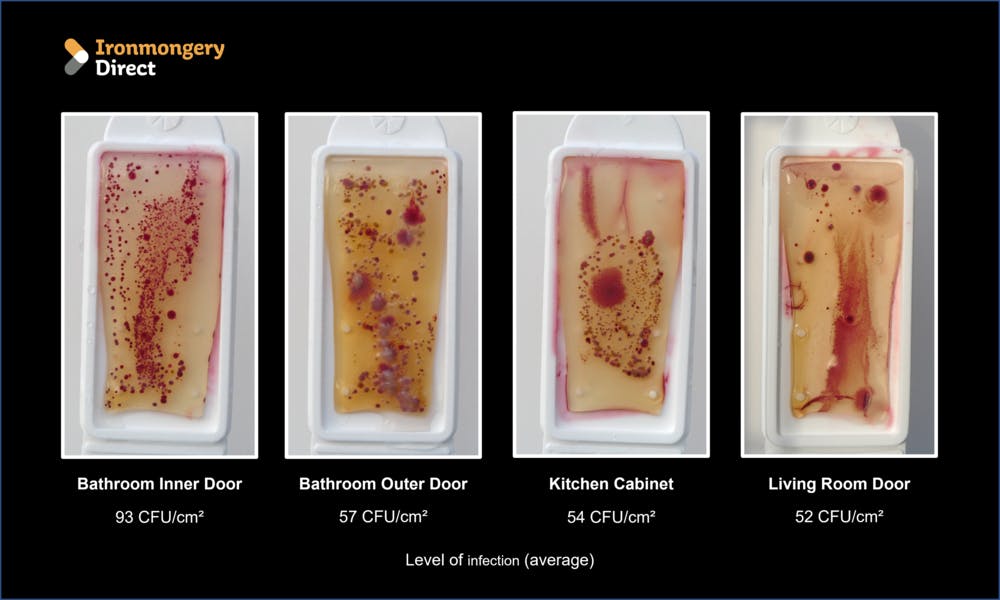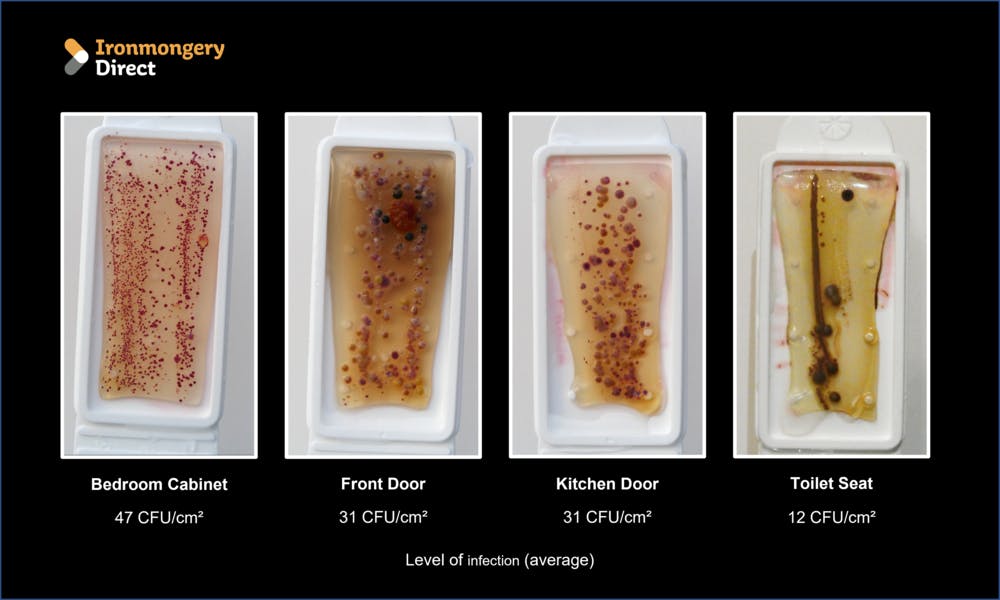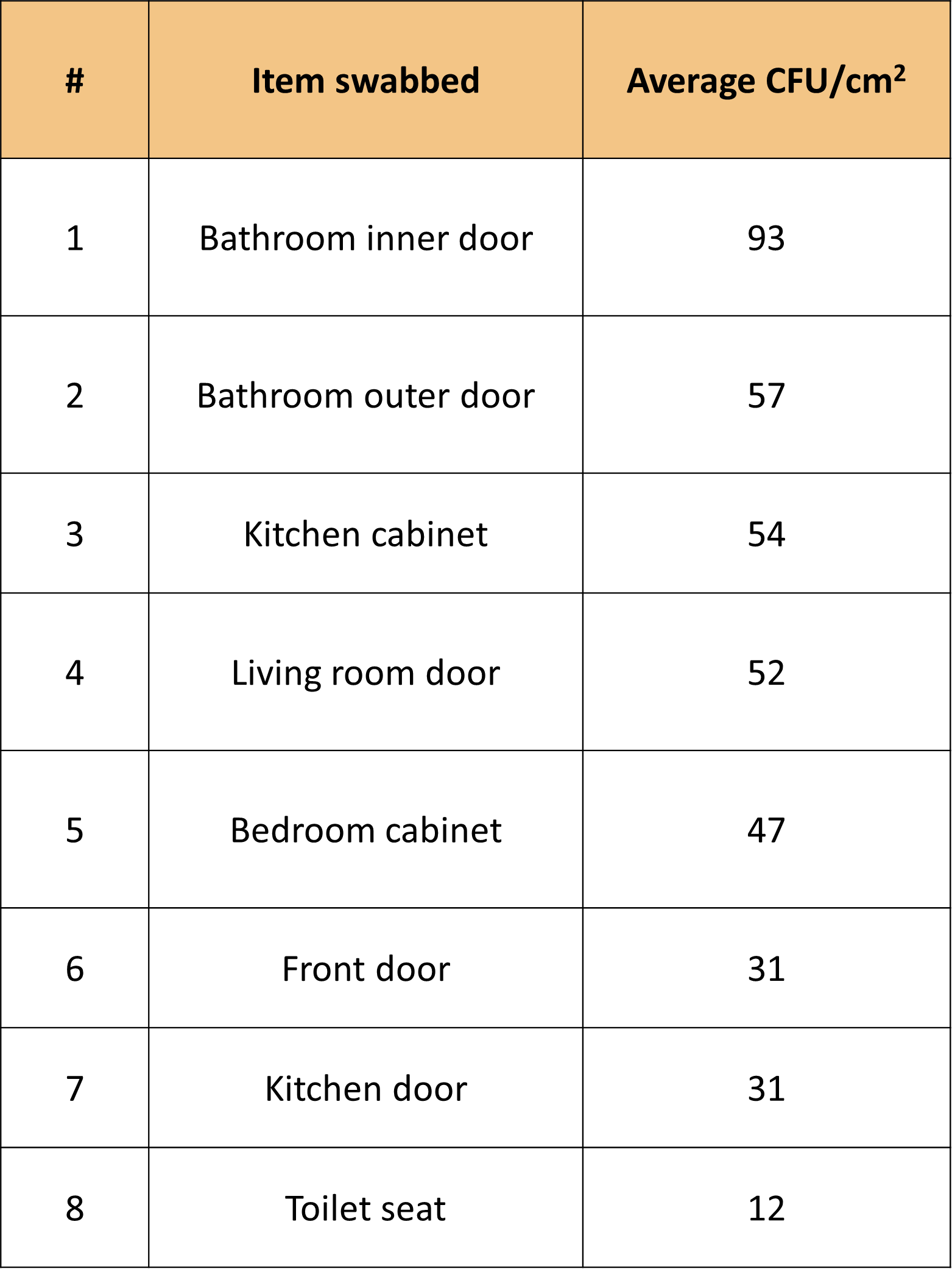4th January 2023
Experts share how to clean your door and cabinet handles
We touch the door and cabinet handles in our home multiple times a day, leaving traces of dirt, grease and bacteria behind with each contact.
IronmongeryDirect
4th January 2023
5 mins
But our recent research found that almost two thirds (63%) of people don’t clean these surfaces enough, and one in seven (14%) don’t clean them at all.
This can have a wide range of consequences and negatively affect both the handles themselves, and the health of anyone who uses them.
To show the importance of keeping these areas clean, we swabbed a variety of handles to reveal the amount of bacteria lurking around the home. Below, you can see the results of our experiment, alongside advice from cleaning experts on how to ensure your door and cabinet handles are as hygienic as possible.
How dirty are your handles?
We used microbiological dipslides to reveal the levels of bacteria living on different handles around the home.
The agar of each slide was held against handles for 15 seconds, before being incubated at 30° Celsius for a week.
The Nutrient agar dipslides contained TTC (red spot dye) to allow easier viewing of the bacteria that grew. Each red dot is an individual bacteria colony.
Our tests found that bathroom door handles, particularly internal ones, hold the most dirt, and are almost eight times filthier than a toilet seat.
In fact, all the handles swabbed in the research were covered in more bacteria than a toilet seat, with living room doors, as well as kitchen and bedroom cabinets, also hosting dozens of colonies.


The dirtiest handles in the home are:

How to clean door and cabinet handles
To help people keep their handles clean, we’ve partnered with a series of cleaning experts to provide their top pieces of advice.
· Sarah Dempsey, cleaning expert at MyJobQuote
· Caroline Rowney, Director at Bacteria Busters
· Karl Huckerby, Managing Director and cleaning expert at Spare and Square
· Dean Davies, cleaning expert at Fantastic Services
1) How often should you clean door and cabinet handles?
Sarah says: “Many homeowners overlook door and cabinet handles when cleaning. It’s just not really something that people think about when cleaning. However, door handles collect germs, dirt, and grease, so it’s important to wipe them down. This should be completed on a weekly basis.”
Karl says: “You should be cleaning door and cabinet handles more often if you have a large household, or if you have lots of guests. You should pay the most attention to handles that are used regularly, as well as those in the bathroom as they are the most likely to be inhabited by germs and bacteria that the naked eye can’t see.”
2) Why should you clean door and cabinet handles?
Karl says: “Door and cabinet handles are two areas in the home that come into the most contact with our hands, which carry on average 3,200 different germs. If you were to touch a door handle that hasn’t been cleaned in a very long time, you could be at an increased risk of coming into contact with germs and bacteria.”
Caroline says: “Whether your home is a hotspot of social activity or you live on your own, it is unlikely that you think about washing your hands before you open any door. That makes handles an excellent place for bacterial transference. Stainless steel handles, in particular, harbour germs for far longer than other surfaces.
“Some of the germs you might find on your typical door or cabinet handle include Salmonella, COVID 19, MRSA and C. Difficile.”
Dean adds: “Handles collect dust, dirt, grease and spills, especially if they are in the kitchen. Sweat is also an issue, as it can leave a corrosive layer on handles which can be damaging, particularly for metal fixtures, like brass.”
3) What is the best way to clean door and cabinet handles?
Caroline says: “If you are in a hurry, a quick spray with isopropyl alcohol will kill most germs. However, to get the best finish from your metal handles, you’ll need to pay a bit more attention. Fill a bowl with warm water and dish soap and soak a cloth in it. Wring it out and use that to clean the handles. Use a clean, dry cloth to wipe away the moisture and then use another cloth to smooth a little wax over the handle to leave it shiny and fresh.”
Dean says: “The best method depends on the material of the handle:”
· Chrome – “Avoid using strong chemicals as they can damage such materials. You can clean such chrome handles using just a microfiber cloth, or a soft one with warm soapy water for even better results.”
· Uncoated brass – “Use a cloth to regularly brush them with white vinegar, before polishing with a separate dry microfibre cloth. If the brass starts to tarnish, rub in a homemade solution of flour, salt and vinegar (a spoonful of each), then wash with clean water, and dry with a clean cloth.”
· Lacquered brass – “Regular dusting will help maintain the lacquer’s quality, but if dirt builds up, clean it with soapy water, then polish with a dry microfibre cloth.”
· Cupboard handles - “Don’t use harsh chemical solutions as they can damage your cupboard, so just use warm soapy water, as this will effortlessly remove grease and dirt.”
If you’re a tradesperson who sometimes installs door or cabinet hardware, you can really make an impression by leaving the handles sparkling clean. For more advice on how to clean different types of hardware, click here.
When should you replace your door and cabinet handles?
Regardless of how often and regularly you clean your door handles, there will always come a time when they need replacing, whether for practical or aesthetic reasons. We asked the experts how frequently you should update the handles in your home.
Caroline says: "A good door handle should last around 25 years, but there are many reasons why you may want to replace them. For example, you may have inherited old handles in your new home and they are now faulty or operating stiffly. Alternatively, you may simply want a change of style, as a new handle can really update the look of your doors."
Dean says: “You can find handles and doorknobs made from different materials and manufacturers which affects the price, quality, and durability. Every handle has its own lifespan, just like everything else in your home. If you have taken good care of it and maintained it correctly, its life should be between seven and ten years.
“However, if certain issues arise, you should replace your handles immediately, as this can increase the lifespan and quality of the door/cabinet itself. Such issues include:
· Having difficulties while locking or unlocking
· Not turning or bouncing back
· Having parts broken or missing
· Wear of the door lever’s spring
· Having the wrong doorknob's grade
Our research has highlighted the importance of regularly cleaning the surfaces in your home, but if you’re looking for a completely fresh start, check out our range of door handles and cabinet handles and knobs online.
